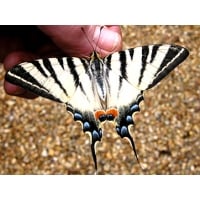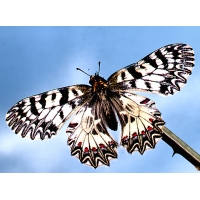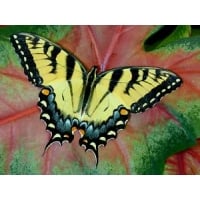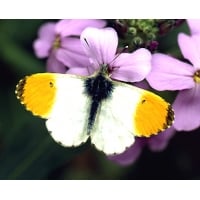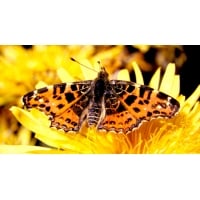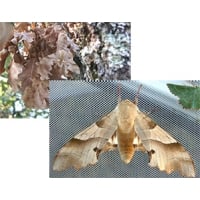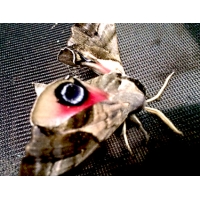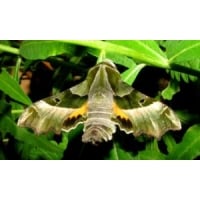WINTER PUPAE for breeding in the following season
European Swallowtail Papilio machaon gorganus
Very difficult to obtain, there are seldom enough to meet demand. Keep winter pupae refrigerated until late April. Lay the pupae on foam sheet in the base of a netting emerging cage. Spray in hot weather. The butterflies normally emerge in May/June.
For breeding, the butterflies require some space, nectar flowers and growing foodplant. They need sunlight and humidity. Give them a shady area in the cage. Eggs are laid on the foodplant leaves.
The larvae are very easy to rear on Fennel, Carrot leaves and Parsnip leaves and flowers (wild and cultivated). One of the most attractive butterfly larvae and a joy to rear!
Scarce Swallowtail Iphiclides podalirius
Good size, plump and clear colour. Increasingly difficult to obtain. The larvae feed on Blackthorn. Most people find this species difficult to breed but it is a joy to have them emerge at home, and worth trying to breed.
The Festoon Zerynthia polyxena Europe
A delicate spring butterfly in the Swallowtail family Papilionidae.
The terrain for this charming species is in mountains, usually lower than 2000m. The species is widely dispursed in southern and eastern Europe and in Russia, seldom occurring in large numbers in any one locality. The Festoon is found in the French and Italian Alps, northwards through Austria to the Czech Republic and Slovakia. It is also found in the mountains of Greece and Bulgaria, Belarus and several mountain ranges in Russia.
The larvae (which are like minatures of Birdwing larvae) feed on Birthwort Aristolochia clematitis, A. rotunda and other local Aristolochia. If you don't have Aristolochia you can search on the internet where plants are for sale.
Store the pupae cold for the winter months. The adults normally emerge from May. There is only one generation in the year.

Black Swallowtail Papilio polyxenes asterias North America
Very closely related to the European and British swallowtails, asterias will often hybridise with either, producing interesting offspring.
The collections of 4 pupae comprise 3 male and a female pupa for breeding.
The larvae feed on Fennel, Carrot tops, and some other Umbelliferae including wild and probably cultivated Parsnip. Two broods are produced in the year and the pupae of the second brood hibernate.
Tiger Swallowtail Papilio glaucus North America
The Tiger Swallowtail is perhaps North America’s grandest swallowtail. As a curiosity, a small proportion of females emerge as melanics, not as beautiful as the typical female, but different! They can be bred in captivity and the larvae are as exotic as many of the tropical swallowtails, with the Papilio eye markings and bird dropping camouflage in the early instars.
Try feeding them on Cherry, Ash or Lime, and they will probably take a wider variety of foodplants.
Orange Tip Anthocharis cardamines Europe
Store the pupae in a cool place, for the winter, even a refrigerator, loose in a plastic box. An early spring butterfly. Depending on locality and season, the butterflies usually begin to fly in May. The male has the orange tips. Both sexes have mottled undersides in green which is actually made of microscopic scales of black and yellow, giving the illusion of green. The curious pupae look like thorns.
Eggs are laid on Garlic Mustard, Sweet Rocket and Cuckoo Flower or Lady’s Smock. The larvae live singly and are canabalistic. Not difficult to breed, particularly on potted foodplant. Camouflage in all stages is remarkable.
Map Butterfly Araschnia levana
A charming and quite small Vanessid butterfly that occurs throughout much of Europe but not in the British Isles. It has been established in Britain but the colony was deliberately destroyed. This is a nettle feeder.
The eggs are laid in unique pendant strings from the underside of a nettle leaf. Younger larvae are gregarious.
There are normally two broods: the spring brood is patterned rather like a fritillary, as illustrated. In July the second brood (form porosa) emerges looking like miniature White Admirals!
An established British colony was deliberately exterminated. Why not try again?
Pairing is not easy but success is more likely if you can create a netting sleeve that brings the two sexes together, like the peak of a hood. Second brood larvae hang up to pupate in secluded places for the winter. The pupae we are offering now are to be stored in a cool outhouse or fridge until April. Then lay them out for emergence in April/May.
Oak Hawk Marumba quercus
A very special European rarity. A much sought after species. The larvae feed on Oaks, with a preference for Evergreen Oaks. Pupae pass the winter and emerge in summer.
Young larvae eat their own egg shell on hatching. They don't take leaf until they have made the first skin change!
Click on picture of dried Oak leaves to see remarkable camouflage
Eyed Hawk Smerinthus ocellata
These pupae will produce moths this year. Pairings extremely easy. Larvae feed on Apple, Willows and Sallows. The larvae do best on living foodplant because these plants do not last well in water. Very attractive larvae, highly camouflaged with silvery markings on green, and very streamlined. Single brooded. The moth has beautiful hindwings which it flashes if disturbed. Huge eyespots brightly coloured with magenta and blue. Highly recommended.
Additional reported foodplants: Poplars, Blackthorn, Lime, Privet, Alder, Birch, Plum, Blackthorn, some Viburnums, Various Prunus, Laurel.
Lime Hawkmoth Mimas tiliae
Some excellent forms of pattern and colour are appearing from these pupae, including one-spot, banded and brick red forms, as well as a wide colour range of normal pattern. There is no way of detecting these in the early stages, but we are illustrating some of these extreme forms that have been emerging.
Store pupae refrigerated for the winter. The moths normally emerge in May/June.
Extremely easy to rear on Lime or Elm. Other reported foodplants include Cherry, Alder, Birch, Oak, Hazel, Acer including Sycamore, Sorbus, Apple, Pear and Ash! In autumn the larvae will grow faster if kept warm.
The larvae do particularly well sleeved on growing foodplant but can be kept in plastic boxes or cages. Beautiful streamlined larvae. Larger larvae are often heavily marked with flame and scarlet spots and blotches. Very variable. They pupate underground. In captivity they will pupate amongst folds of cloth or absorbent tissue.
Privet Hawk Sphinx ligustri
SPECIAL OFFER 5 pupae £22.95 NOW £17.95 10 pupae £39.95 NOW £35.95 20 pupae £79.90 NOW £66.00
One of the largest Hawkmoths. Keep pupae cool for breeding next year.
The caterpillar becomes enormous and is characteristic of the name Sphinx moths, by its sphinx-like resting position. Adults emerge in June and July. They need nectar from the flowers of Privet, Valerian, Buddleia.
Larval foodplants: Privet, Lilac, Ash, also reportedly Spiraea, Viburnum opulus, and other Viburnums, Holly, Dogwood, Snowberry, Apple, Pear, Oleander, Leycesteria, Currant.
One generation in the year. Privet Hawks breed readily in a large cage with nectar and foodplant.
Willowherb Hawkmoth Proserpinus proserpina
SCARCE! Only a few pupae available.
This rather rare Hawkmoth is a gem, seldom encountered, though it lives throughout much of western and central Europe, eastwards into Russia.
The larva is rather like a grey form of Small Elephant Hawk. The foodplant is Rosebay Willowherb Epilobium, Evening Primrose Oenothera and Purple Loosetrife Lythrum. The pretty little green moth has prominent egg-yolk coloured hindwings. The normal flight period is June and July.


